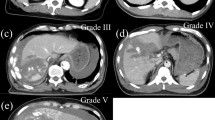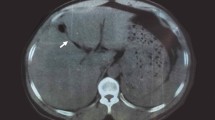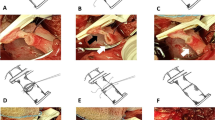Abstract
Background
Delayed postoperative arterial bleeding is rare and may be life-threatening. When the bleeding source is the hepatic artery, complete ligation or embolization from the proximal to the distal area of the ruptured lesion usually results in complete occlusion of hepatic arterial flow.
Methods
To evaluate the frequency and severity of ischemic liver injury following complete hepatic artery occlusion, a retrospective study was conducted. Patients who underwent complete hepatic artery occlusion in the treatment of delayed postoperative arterial bleeding between January 2007 and December 2014 in our institution were reviewed. Changes of hepatic function and rates of associated complications and prognosis were analyzed.
Results
A total of 24 patients experienced 26 episodes of bleeding. Nineteen experienced transient liver enzyme elevation alone. There were no signs of acute liver failure after complete hepatic artery occlusion. The rates of liver infarction and liver abscess were 23.8 % (5/21) and 19 % (4/21), respectively. The 30-day mortality rate was 8.3 % (2/24).
Conclusion
Complete occlusion of the hepatic artery does not always result in severe hepatic ischemic injury. As a common cause of delayed postoperative bleeding, intra-abdominal infection may be fatal when it is not controlled successfully.


Similar content being viewed by others
References
Balachandran P, Sikora SS, Raghavendra Rao RV, Kumar A, Saxena R, Kapoor VK. Haemorrhagic complications of pancreaticoduodenectomy. ANZ J Surg. 2004;74:945–950.
Tien YW, Lee PH, Yang CY, Ho MC, Chiu YF. Risk factors of massive bleeding related to pancreatic leak after pancreaticoduodenectomy. J Am Coll Surg. 2005;201:554–559.
Koukoutsis I, Bellagamba R, Morris-Stiff G, et al. Hemorrhage following pancreaticoduodenectomy: risk factors and the importance of sentinel bleed. Dig Surg. 2006;23:224–228.
Boggi U, Del Chiaro M, Croce C, et al. Vascular complications of pancreatectomy. JOP. 2007;8:102–113.
Reber PU, Baer HU, Patel AG, Triller J, Büchler MW. Life-threatening upper gastrointestinal tract bleeding caused by ruptured extrahepatic pseudoaneurysm after pancreatoduodenectomy. Surgery. 1998;124:114–5.
Sato A, Yamada T, Takase K, et al. The fatal risk in hepatic artery embolization for hemostasis after pancreatic and hepatic surgery: importance of collateral arterial pathways. J Vasc Interv Radiol. 2011;22(3):287–93.
Cho SK, Kim SS, Do YS, et al. Ischemic liver injuries after hepatic artery embolization in patients with delayed postoperative hemorrhage following hepatobiliary pancreatic surgery. Acta Radiol. 2011;52(4):393–400.
Hur S, Yoon CJ, Kang SG, et al. Transcatheter arterial embolization of gastroduodenal artery stump pseudoaneurysms after pancreaticoduodenectomy: safety and efficacy of two embolization techniques. J Vasc Interv Radiol. 2011;22(3):294–301
Miura F, Asano T, Amano H, et al. Management of postoperative arterial hemorrhage after pancreato-biliary surgery according to the site of bleeding: re-laparotomy or interventional radiology. J Hepatobiliary Pancreat Surg. 2009;16(1):56–63.
Sato N, Yamaguchi K, Shimizu S, et al. Coil embolization of bleeding visceral pseudoaneurysms following pancreatectomy: the importance of early angiography. Arch Surg.1998;133(10):1099–102.
Reber PU, Baer HU, Patel AG, Wildi S, Triller J, Büchler MW. Superselective microcoil embolization: treatment of choice in high-risk patients with extrahepatic pseudoaneurysms of the hepatic arteries. J Am Coll Surg. 1998;186:325–30.
Brodsky JT, Turnbull AD. Arterial hemorrhage after pancreatoduodenectomy. The ‘sentinel bleed’. Arch Surg. 1991;126:1037–40.
Shibata T, Sagoh T, Ametani F, Maetani Y, Itoh K, Konishi J. Transcatheter microcoil embolotherapy for ruptured pseudoaneurysm following pancreatic and biliary surgery. Cardiovasc Intervent Radiol. 2002;25(3):180–5.
Fujii Y, Shimada H, Endo I, et al. Management of massive arterial hemorrhage after pancreatobiliary surgery: does embolotherapy contribute to successful outcome? J Gastrointest Surg. 2007;11(4):432–8.
Ong GY, Changchien CS, Lee CM, et al. Liver abscess complicating transcatheter arterial embolization: a rare but serious complication. A retrospective study after 3878 procedures. Eur J Gastroenterol Hepatol. 2004;16:737–742.
Tajima Y, Kuroki T, Tsutsumi R, Sakamoto I, Uetani M, Kanematsu T. Extrahepatic collaterals and liver damage in embolotherapy for ruptured hepatic artery pseudoaneurysm following hepatobiliary pancreatic surgery. World J Gastroenterol. 2007;13(3):408–13.
Miyamoto N, Kodama Y, Endo H, Shimizu T, Miyasaka K. Hepatic artery embolization for postoperative hemorrhage in upper abdominal surgery. Abdom Imaging. 2003;28(3):347–53.
Reber PU, Baer HU, Patel AG, Triller J, Büchler MW. Life-threatening upper gastrointestinal tract bleeding caused by ruptured extrahepatic pseudoaneurysm after pancreatoduodenectomy. Surgery. 1998;124(1):114–5.
Heiss P, Bachthaler M, Hamer OW, et al. Delayed visceral arterial hemorrhage following Whipple’s procedure: minimally invasive treatment with covered stents. Ann Surg Oncol. 2008;15:824–832.
Iseki J, Touyama K, Noie T, et al. Partial portal arterialization for the prevention of massive liver necrosis following extended pancreatobiliary surgery: experience of two cases. Surg Today. 1992;22:568–571.
Harvey J, Dardik H, Impeduglia T, Woo D, DeBernardis F. Endovascular management of hepatic artery pseudoaneurysm hemorrhage complicating pancreaticoduodenectomy. J Vasc Surg. 2006;43(3):613–7.
Paci E, Antico E, Candelari R, Alborino S, Marmorale C, Landi E. Pseudoaneurysm of the common hepatic artery: Treatment with a stent-graft. Cardiovasc Interv Radiol. 2000;23:472–484.
Zhang J, Zhu X, Chen H, et al. Management of delayed post-pancreaticoduodenectomy arterial bleeding: interventional radiological treatment first. Pancreatology. 2011;11(5):455–63.
T. Miura, K. Hakamada, T. Ohata et al. Resection of a locally advanced hilar tumor and the hepatic artery after stepwise hepatic arterial embolization: a case report. World Journal of Gastroenterology. 2008;14(22):3587–3590.
Yoon YS, Kim SW, Her KH, et al. Management of postoperative hemorrhage after pancreatoduodenectomy. Hepatogastroenterology. 2003;50:2208–12.
Michels NA. Newer anatomy of the liver and its variant blood supply and collateral circulation. Am J Surg. 1966;112:337–47.
Michels NA. Collateral arterial pathways to the liver after ligation of the hepatic artery and removal of the celiac axis. Cancer. 1953;6(4):708–24.
Kim W, Clark TW, Baum RA, Soulen MC. Risk factors for liver abscess formation after hepatic chemoembolization. J Vasc Interv Radiol. 2001;12:965–8.
Yoshida T, Matsumoto T, Morii Y, et al. Delayed massive intraperitoneal hemorrhage after pancreatoduodenectomy. Int Surg. 1998;83:131–135.
Takeuchi Y, Arai Y, Inaba Y, Ohno K, Maeda T, Itai Y. Extrahepatic arterial supply to the liver: observation with a unified CT and angiography system during temporary balloon occlusion of the proper hepatic artery. Radiology. 1998;209(1):121–8.
Hankins D, Chao S, Dolmatch BL, Jeyarajah RD. Covered stents for late postoperative arterial hemorrhage after pancreaticoduodenectomy. J Vasc Interv Radiol. 2009;20(3):407–9.
Author information
Authors and Affiliations
Corresponding author
Rights and permissions
About this article
Cite this article
Zhang, J., Qian, Hg., Leng, Jh. et al. Ischemic Liver Injury After Complete Occlusion of Hepatic Artery in the Treatment of Delayed Postoperative Arterial Bleeding. J Gastrointest Surg 19, 2235–2242 (2015). https://doi.org/10.1007/s11605-015-2930-0
Received:
Accepted:
Published:
Issue Date:
DOI: https://doi.org/10.1007/s11605-015-2930-0




